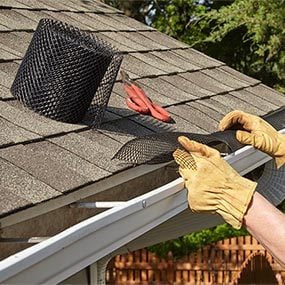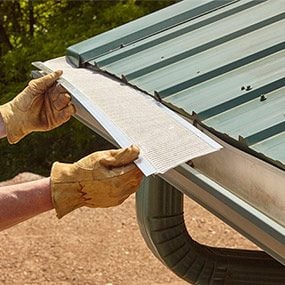Cleaning out gutters
Cleaning out gutters is a miserable, messy, stinky job. Installing gutter guards could put that headache behind you, but how the heck are you supposed to know which type to buy? In this article, we'll examine the three most popular types of gutter guards: screen, surface tension and fine mesh. We'll compare the different features, installation methods and prices to help you decide which ones will work best for your house. And if you install them yourself, you can save tons of money-some pro installers charge as much as $20 per ft.! The guards we'll cover are designed for 5-in. K-style gutters, typical on many homes.

Screens are the most common type of gutter guard. They come in a wide variety of shapes and materials and can be installed in a few different ways. Screens work well in situations where leaves are the main problem. However, the openings in screens are large enough to let in seeds and pine needles, and cleaning them out may require removing the screens. Second, the screens themselves can become plugged, and cleaning screens can be tricky because some of the debris gets entangled and isn’t easily brushed or blown off. So if you currently find lots of seeds or needles in your gutters, screens may help, but don’t expect them to eliminate gutter chores.
Screens are the easiest to install. Some can be slid up under the shingles, which is ideal because the screen will angle downward and allow debris to slide off the roof. Other screens just drop in, which makes them a good choice if you have old, brittle shingles, or a shingle type other than asphalt that can’t be pried up.

With surface-tension gutter guards, water clings to the rounded nose of the guard and flows into the gutter, while leaves and other debris fall off over the edge. Surface-tension guards work very well with leaves and other large debris. Small debris sometimes gets in but usually washes out the downspouts without a problem.
This type of guard works only if the guard is installed at an angle that’s similar to the slope of the roof. This isn’t always possible on long gutter runs because the gutters need to be pitched so the water flows to the downspouts, which means one end will need to be hung high. If you install surface-tension guards on gutters that are mounted high on the fascia, they will cause debris dams and allow more junk inside the gutter.
Surface-tension gutter guards are more visible than other styles, and water can shoot over them in heavy downpours. However, if they’re installed correctly, the amount of debris that enters the gutter is usually small enough to be washed away, and the solid surface of the guards can be cleaned with just an occasional spraying with a garden hose.

Fine-mesh guards function like screens, but they block all but the smallest debris. The tiny spaces in the mesh won’t clog with seeds and needles, but they can fill with small particles like shingle grit. Fine-mesh gutter guards still need an occasional cleaning, but unlike screens, fine mesh is easy to blow or brush clean.
This EasyOn product can be installed under the shingles, or the back can be bent up and screwed to the fascia. This method strengthens the gutters themselves, making them hold up better to snow and ice avalanches, which are common with steel roofs in cold climates.
Fine-mesh products made with window-type screen material are easily damaged by ice and branches. The good ones will be made from tough surgical stainless steel.
Comments
Post a Comment